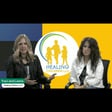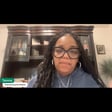Introduction to Guardians of Hope Podcast
00:00:06
Speaker
Welcome to the Guardians of Hope podcast where we bring together parents, nonprofits, legal and medical experts dedicated to positively impacting children's lives. I'm your host, Cynthia Ramserin. The purpose of this podcast is to inform and unite. Please seek advice from your attorney or doctor to address your specific needs.
00:00:29
Speaker
The thoughts and opinions of my guests are not necessarily my own. So thank you all for joining and sharing. Welcome, everyone.
Incarceration and Abuse Statistics
00:00:38
Speaker
I recently read an article in the New York Times stating that there are over 12,000 women incarcerated in the United States for homicide, a broad category that ranges from manslaughter to first degree murder.
00:00:54
Speaker
We do not know and have never known how many of these women killed someone who was abusing them. Every year three to four million women in the United States are abused and nearly 1,600 are killed by their abusers. The challenge for those who encounter abused women is to identify those with the highest level of danger.
The Danger Assessment Tool
00:01:16
Speaker
25 years, the danger assessment and instrument has been used by law enforcement, healthcare professionals, and domestic violence advocates. Here to discuss this assessment and community-wide efforts to support women and children in crisis is Ramona Jackson, the Women's Advocacy Center founding president and CEO. Ramona, thank you so much for joining me. It's always great to see you.
00:01:44
Speaker
Hey, Cynthia. It's really great to see you as well. Thank you for having me today. Of course. Now, in terms of the article, given your history as an attorney and founder of the Women's Advocacy Center, what are your thoughts?
Complexities of Domestic Abuse
00:01:59
Speaker
Well, you know, my first thought when I read the article was surprise. I didn't know the number of women who were incarcerated after having um murdered an abuser or at least been aware of the murder of an abuser. And I didn't practice criminal law, so I i didn't know a lot of the nuances of that. But what was also striking was that these ladies who were incarcerated, um that many of them, they had a long life sentence, and it was without parole.
00:02:36
Speaker
And even though I don't understand criminal law that well, what I do understand are the dynamics of domestic abuse. And I understand battered women's syndrome. I understand the intersectionality of domestic abuse in other areas of a woman's life. And Rachel Louise Snyder, who wrote that article, she's a powerful voice for women who have been abused. And in her book, No Visible Bruises, what we don't know about domestic violence can kill us.
00:03:04
Speaker
I was impressed with the balance and the care and the thoughtfulness with which she described domestic abuse and all of the different pieces that intersected and that was the same balance and care that she used when writing this article for the New York Times and um I think it's important. I think the article is important because she's not just reporting the
Importance of Danger Assessment
00:03:25
Speaker
facts. She's really challenging us to look deeply and thoughtfully at what is behind this data, what's behind these numbers and how are women and their children impacted, not just by abuse, but then by the aftermath of that abuse and in this case, women being imprisoned because of the the murder of the abuser.
00:03:47
Speaker
Thanks, Ramona, for that. The article went into danger assessment. That's a tool that predicts predicts the risk of death from an intimate partner. How widely used is this? And another question, why is it important that the results are taken seriously?
00:04:06
Speaker
Well, I think the dangerous assessment is used pretty widely by victim service organizations across the country. We use it at our organization, and the main purpose of that assessment, as far as I'm concerned, is really to help a a survivor or a victim to understand the level of risk that she could possibly experience if she remains in that relationship with the abuser. The series of questions that are asked are looking to identify a pattern of behavior over a period of time. And it's really helpful when a ah person who takes that assessment then sees the outcome of that assessment and becomes more aware of the high level of risk that they have um with that abuser.
00:04:54
Speaker
Once we have the assessment, it's really helpful to begin to inform how we are going to serve that victim. What does she need to help keep her safe? How can law enforcement get involved? Are there other agencies in the community that can get involved? And I, like Ms. Snyder and others, would believe that I believe that there's a collaborative approach to the danger
Challenges in Leaving Abusers
00:05:17
Speaker
assessment. And when I say that, I mean that If other agencies um and law enforcement are involved and are aware of the level of risk, then there are some steps that can be taken, such as emergency housing, making sure that the bill does not allow the abuser to be released, and and other steps that can be taken to hopefully keep not just that abuser and any dependents that she has safe, but also law enforcement and innocent bystanders.
00:05:46
Speaker
You know, and this then leads to thinking about the second part of your question, which is why does the dangerous assessment need to be taken seriously? Well, certainly because it helps to it could point to ways that could help prevent a fatality. But also, if you're looking at um the fact that those women who scored extremely high on that dangerous assessment in the year before the abuser was murdered. That point is not lost on me. That there's a way for us to intervene early. There's a way for us to intervene early, the systems that are in place in communities around the country. There are ways that we can intervene early and hopefully prevent further violence from happening and certainly prevent
00:06:32
Speaker
those fatalities. um Now I'm not naive enough to think that every time there's an assessment done and every time a woman sees the outcome of that assessment that she then says yes I want help and yes I want to take advantage of the services that are available. um Sometimes women decide not to leave and there are a host of reasons for that and we would need a separate podcast to to unpack and talk about that, but what I would like to say is that when that woman does decide that she wants help, then we as a community, we as service providers, we we have a responsibility to step in and to provide her with what she needs in the community where she lives. This is an important point that I often make is that women shouldn't have to travel
00:07:22
Speaker
um have an hour, an hour or more to get services, we should be able to rev provide ladies with services in the communities where they live. It makes it easier. It makes it more likely that they're going to take advantage of those services. It is also more likely that if we are in the community where women live and work, that we are able to be more responsive, that we have a better understanding of the dynamics of that community. The other point that I want to make here is that sometimes people will ask, well, if she's at a really high level of risk and if there are supportive services available, then why doesn't she just leave? And I just want to give this statistic that um when women are preparing to leave, they are at
00:08:08
Speaker
an extremely high level of being killed, right? So if the abuser has access to a gun, this is a statistic that I've read recently. ah The victim is 1000% more likely to be killed when she's trying to leave. For victims who have been strangled, the risk of homicide increases by 750%.
00:08:31
Speaker
well when they are trying to leave. So if some if a woman has thought, you know he's threatened to kill me, he's been aggressive with me and maybe aggressive with any dependence that I have, I tried to get help from law enforcement or maybe from the courts and I've not received that kind of assistance. And now he's telling me that if I leave, he's going to kill me.
00:08:53
Speaker
Is a woman likely to take that seriously? I would say yes. She is likely to think that he's going to harm her. And in order to survive and in order to keep her children safe, she is likely not to leave.
Role of CCRTs in Domestic Abuse Cases
00:09:05
Speaker
So those are you know just some of the thoughts that I have around those questions. Mona, thank you. Now, leaning more into this community response, let's talk about CCRT and how that can work successfully.
00:09:23
Speaker
Well, CCRT is an acronym or a collaborative community response team. And the way that that team works is they take a case of domestic abuse and they look at that case um with as much information that they have. So for instance, they may ask things like,
00:09:43
Speaker
Well, when did this family first have an interaction with law enforcement and what agencies have been involved with this family? They might ask whether or not DCS has been involved. They might ask the number of times that law enforcement has been involved with that family, whether the abuser has been arrested and if so, is he still incarcerated or has there been Bail said there are a series of questions that that team will ask as they're looking at how could perhaps a fatality have been ah been prevented or what steps can be taken now to make sure that a fatality does not occur. And recently I participated in one of these calls and and the discussion was really vibrant. The discussion was really good and the follow-up
00:10:28
Speaker
action items on this is what we need to do to check in to be sure that this victim and any dependents that she has remain safe. There's a place for judges in this system, there's a place for medical professionals and counselors in this system, and making sure that the right people are at the table when you're looking at a CCRT is important.
00:10:51
Speaker
because when you identify those gaps, when you're looking at what could we do or what could have happened to prevent this fatality, you want decision makers at the table who can say, this is what we can do the next time to close that gap. This is what we can do to make sure that this doesn't happen again. And that can mean not only that a survivor and her children, a woman and her children are protected, but it also could prevent a fatality of the abuser. It could prevent law enforcement from being injured, or as I said before, in a supply standard.
CCRT Awareness and Education
00:11:23
Speaker
So the collaborative nature of this team to me is what makes it very powerful and a really force for good in the community when you're looking at domestic abuse and how can we prevent it? How can we keep people safe?
00:11:38
Speaker
Ramona, in a perfect world, it would prevent every case from happening or it would prevent you know fatalities from happening all the time. Obviously, there are roadblocks um from preventing or creating them for communities. What are some of those roadblocks that you're seeing?
00:11:57
Speaker
Yeah, those roadblocks can seem overwhelming or as if you know there' we're not going to move past it. i mean When I first started learning about this and talking with community leaders about the CCRT, what I've noticed as ah a major roadblock, it's really a lack of awareness and education. so there's not a real familiarity with CCRT in some parts of the country and and how they can benefit the community and how they can protect women and their children. And I speak about women and children not to say that men are not also victimized, but our organization, the Women's Advocacy Center, we serve women and children. And so that's usually the framework from which I speak.
00:12:44
Speaker
but having a level of awareness and education about how a CCRT can work and how it works to serve the community. I mean, it's not like we're reinventing the wheel. This has been done across the country in a number of places. And so um sometimes I think it's just a matter of having people like me and other victim service providers helping to educate law enforcement, helping to educate community leaders, and helping them to see how it benefits. And really, this is important too, not just that individual family, but the entire community. There are a lot of resources that are spent when there is domestic abuse in an individual family.
00:13:24
Speaker
I've mentioned law enforcement several times. I've mentioned counselors, medical professionals, the school. There are a lot of resources, the judiciary that are involved when a family is experiencing domestic abuse. So the collaborative nature of this team takes all of that knowledge from the community into consideration and uses it, focuses it to help us identify ways to close those systemic gaps and protect those families and hopefully um prevent someone from losing their life.
Support Services by Women's Advocacy Center
00:14:01
Speaker
Ramona, your organization helps a lot of women and children in crisis. Can you talk um more or share more details about how your organization is helping around you know community collaboration?
00:14:16
Speaker
Yeah, thanks for that, Cynthia. We are learning as much as we can about CCRTs. We are participating in those meetings with other community partners as we begin to move forward in this way. We are learning what other agencies like ours are doing, not just across our community, but really across the state and across the country. Frequently, I am participating in webinars and conferences to learn as much as I can.
00:14:42
Speaker
to bring that back and say here is a success story from some other part of the country and here is maybe a piece of that or several pieces of that that we can use in our community and then that way we are in that way we are educating others we're helping them to understand how a CCRT works and what success looks like when you use that tool and then we are advocating like for the past two years we have given our voice um to advocate on behalf of abused women and children to get lost chains that would benefit them um to making sure that the people who make decisions about funding know where that funding is needed and how it's needed to support women and children who are escaping
00:15:29
Speaker
an abuser, and we are raising funds. So our organization provides a lot of support services to women and children who have fled or are preparing to flee an abuser. Some of those services include emergency housing, our meal program, transportation assistance, assistance with rent, and just a host of other services, a legal advocacy that help ladies as they're trying to transition out of that abusive relationship and into a place of safety and so we've got an upcoming event called the purple party and we wear purple to honor survivors and victims and we are not celebrating domestic abuse at that party what we are celebrating are the voices of survivors and we are celebrating their resiliency
00:16:22
Speaker
and we are raising funds to help us to continue to support them as they move forward.
Call to Action and Support
00:16:30
Speaker
You're doing an amazing job and I admire your organization so much Ramona. Tell everyone where we can find you online and support and donate. Thanks Cynthia. Well you can go to our website which is www.womensadvocacycenter dot.org ah You can also find us on Facebook and Instagram and there's a lot of promotional material there now about our upcoming event but there's also information there on the stories of ladies that we have served and we may have changed a few facts just to
00:17:05
Speaker
can make sure that their identity is not discovered, but these are real stories of real women that we have served and You can read about how they came to us and then how we were able to assist them um You can also you know learn more about us in various news articles and a podcasts like this this week I have a few different places where I'll be and speaking throughout the month actually because it's Domestic Violence Awareness Month and so you can learn more about that by also visiting our website and on our social media pages.
00:17:44
Speaker
Excellent. I will be sure to link your website and tag your social media on this podcast description. Ramona, thank you so much for your time. As always, it's so great to have you on to discuss important topics, especially during domestic abuse um awareness month. So thank you so much for your time.
00:18:06
Speaker
Yeah, thank you, Cynthia. I really appreciate you being a leader on your podcast and talking about difficult topics and having just a a wide breadth of people to come on and and speak about those things that impact children and our community. So thank you for your boldness and for your leadership. Thank you. I appreciate that. ah You're welcome. You're welcome.




















